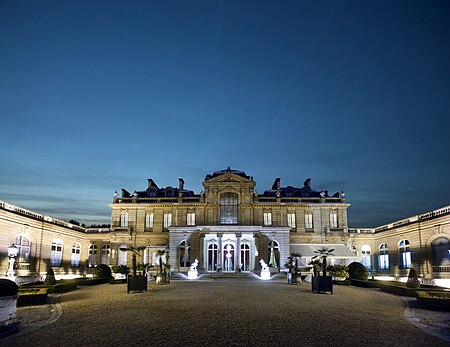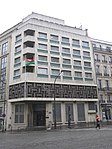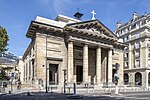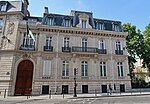The Exposition Internationale du Surréalisme was an exhibition by surrealist artists that took place from January 17 to February 24, 1938, in the generously equipped Galérie Beaux-Arts, run by Georges Wildenstein, at 140, Rue du Faubourg Saint-Honoré in Paris. It was organised by the French writer André Breton, the surrealists' brain and theorist, and Paul Éluard, the best known poet of the movement. The catalogue listed, along with the above, Marcel Duchamp as generator and arbitrator (to appease the partly fierce conflicts mainly between Breton and Éluard), Salvador Dalí and Max Ernst as technical advisers, Man Ray as head lighting technician and Wolfgang Paalen as responsible for the design of the entrance and main hall with "water and foliage". The exhibition was staged in three sections, showing paintings and objects as well as unusually decorated rooms and mannequins which had been redesigned in various ways. With this holistic presentation of surrealist art work the movement wrote exhibition history.
Before their first group exhibition in November 1925, which took place in Pierre Loeb's gallery "Pierre" in Paris, the surrealist artists had previously shown their works at solo exhibitions. The group exhibition showed works of Giorgio de Chirico, Hans Arp, Max Ernst, Paul Klee, Man Ray, André Masson, Joan Miró, Pablo Picasso and Pierre Roy. Another joint exhibition followed in 1928 in the Parisian gallery "Au Sacre du Printemps" with the title "Le Surréalisme, existe-t-il?" (Does Surrealism really exist?) Among the participants were Max Ernst, André Masson, Joan Miró, Francis Picabia und Yves Tanguy. Further group exhibitions followed. In 1931 the first surrealist exhibition in the US took place in the Wadsworth Atheneum in Hartford, Connecticut, and in May 1936 the "Exposition surréaliste d'objets" was held in the Parisian gallery Charles Ratton, which particularly valued object art and also referred to Primitivism, sexual fetishes and mathematical models.In June of the same year the International Surrealist Exhibition was launched in the New Burlington Galleries in London. These exhibitions still made use of the usual form of representation, i.e. the White Room, which was designed at the "Sonderbund" exhibition in Cologne in 1912. In 1938 however, André Breton wanted to establish a framework for the surrealist art in the Beaux Arts Gallery, in which the presentation itself was surrealist art. As a creative act it was to be a surreal experience, in which paintings and objects served as elements in a completely surrealist environment.At the end of 1937, André Breton and Nusch Éluard asked Duchamp to contribute ideas to the surrealist exhibition they were planning. Duchamp had already presented his works at previous exhibitions, but he never became a member because of his principle never to be part of any group. Nevertheless, Duchamp accepted the invitation to help design the exhibition. This led to cooperation on further projects, such as the First Papers of Surrealism exhibition, which took place in New York City in 1942. Various discreet meetings were held together with the inner circle of responsible curators and designers (Marcel Duchamp, Wolfgang Paalen, Man Ray, Max Ernst, Salvador Dalí) to discuss the general outlines and specific thematical questions.








